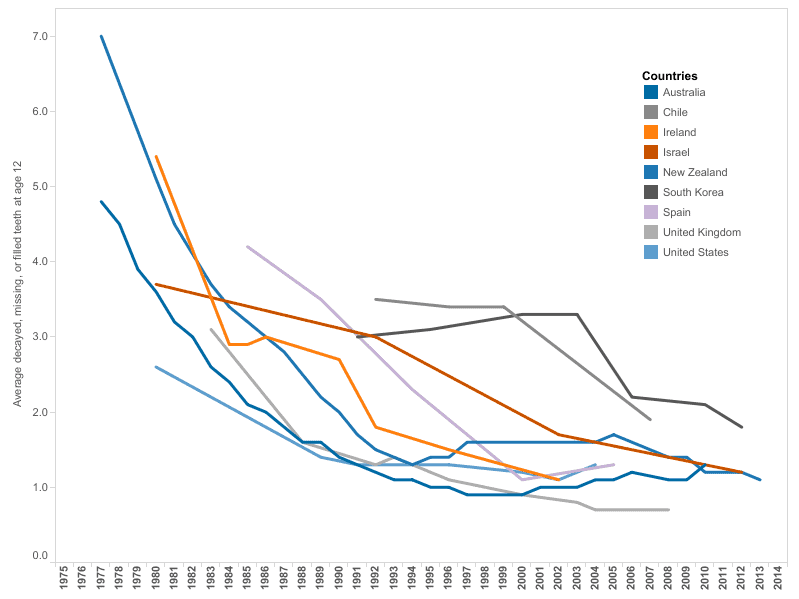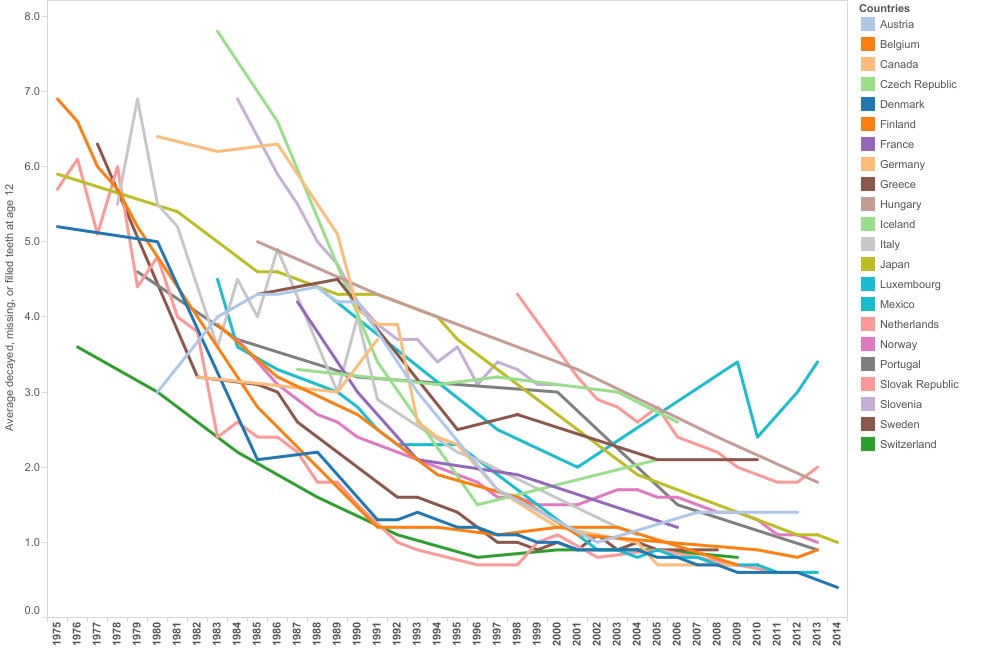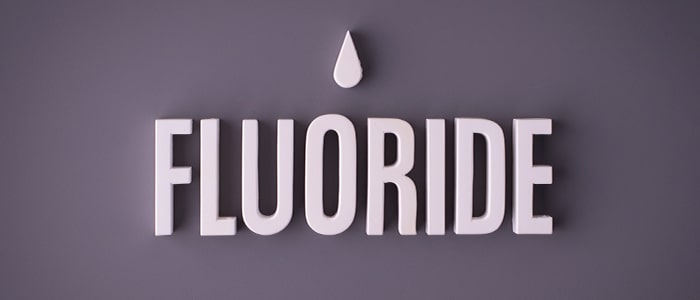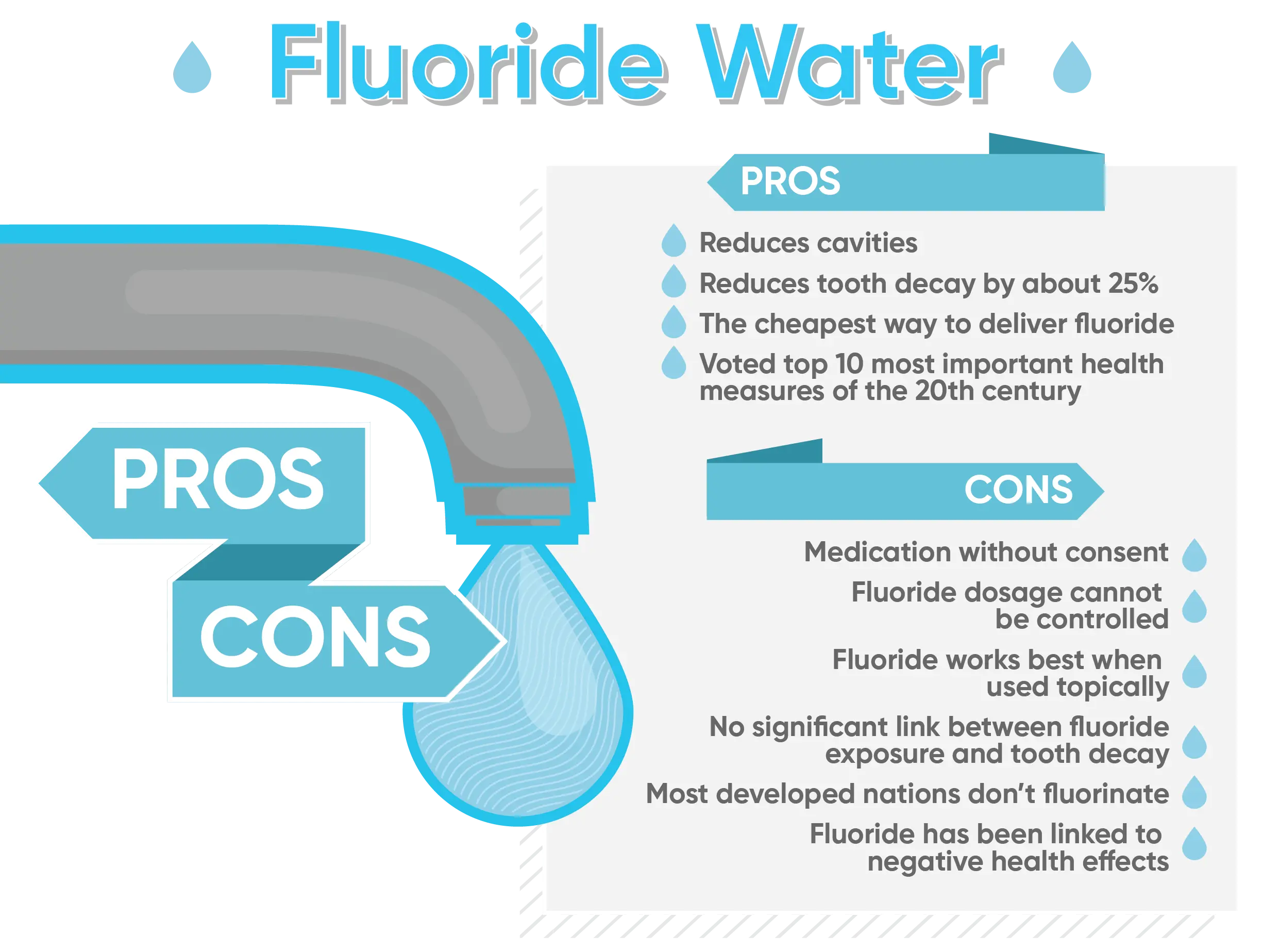UPDATED ON:
The topic of adding fluoride to drinking water supplies has been largely controversial for several decades. Many people support the potential health benefits of fluoridated water while others have voiced their doubts. Some have even expressed their opposition to what they consider forced medication by the government.
Due to the longstanding controversy, we’re taking a closer look at everything you need to know about water fluoridation, including answering the two most prominent questions within this topic: 1) What are the benefits of fluoride in your water supply? and 2) Is fluoride bad for you?
What Is Fluoride?
Fluoride is a naturally occurring mineral that’s released from rocks into the soil, water, and air. It aids in the mineralization process for bones and teeth and plays a role in cavity prevention. Nowadays, fluoride can be ingested or applied topically, and it comes from significant sources such as:
- Drinking water: All water contains some fluoride but not enough to have a significant impact on your health. So when dental research revealed that adjusting the fluoride level of a water supply can support improved oral health, fluoridating water quickly became commonplace. According to the Centers for Disease Control and Prevention (CDC), 75% of a person’s fluoride intake comes from drinking water with added fluoride.
- Certain foods: Some foods naturally contain fluoride due to the mineral’s presence in soil and water used for agriculture. Consuming foods and beverages like seafood, tea, grains, cereal products, fruits, and vegetables contributes to greater daily intake.
- Dental care products: Fluoride mouthwash and toothpaste are now common dental products, designed to strengthen tooth enamel and fortify teeth against decay. Using topical fluoride is an efficient method to guarantee sufficient exposure.
- Fluoride supplements: Supplements that provide additional fluoride exist to aid in cavity prevention and dental health maintenance, particularly in regions where water or food sources lack adequate levels.
How Is Water Fluoridated?
Public drinking water becomes fluoridated when the naturally occurring fluoride levels are adjusted with chemical fluoride to the optimal range, where the U.S. Public Health Service recommends the ideal water fluoridation levels. Today, about 73% of Americans drink fluoride through a public water supply, per the CDC.
But, when did water fluoridation begin?
The History and Use of Fluoride in Drinking Water
In January 1945, Grand Rapids, Michigan, became the world’s first city to adjust its level of fluoride in water. This community water fluoridation was intended as a project for monitoring its effects. What’d they find? Moderate fluoride intake does wonders for dental health: minimizing dental caries, also known as cavities, and strengthening tooth enamel. This meant that, for the first time in history, tooth decay was now a preventable disease for most people.
In 1962, the Department of Health and Human Services (DHHS) recommended that public tap water should contain fluoride levels between 0.7 and 1.2 mg/L to support public health and prevent widespread cavities. But, in 2015, the department changed its recommendation level to not exceed 0.7 mg/L because many people receive added fluoride exposure through toothpaste, mouthwash, and other dental products.
Global Variations in Water Fluoridation Policies
It’s important to keep in mind that water fluoridation policies vary widely across the globe, with some countries implementing widespread fluoridation programs and others abstaining entirely. For instance, countries like the U.S. and Australia have long-standing fluoridation initiatives supported by public health authorities. However, many European nations have opted against fluoridating their water supplies due to concerns about safety and individual choice. These global variations highlight the complex interplay of cultural, political, and scientific factors shaping water fluoridation policies worldwide.
Take a closer look at countries and their water fluoridation policies below:
Countries With Fluoridated Water

Source: OECD.Stat/Dental Health
Countries Without Fluoridated Water

Source: OECD.Stat/Dental Health
Why Is Fluoride in Water Controversial?
Despite the evidence that fluoride is beneficial for oral health, community water fluoridation has been controversial since its inception. Why? Concerns have been raised about the potential health effects of ingesting fluoride at varying concentrations — with excessive levels contributing to dental fluorosis or skeletal fluorosis.
Studies from the National Library of Medicine indicate a rising global occurrence of dental fluorosis, affecting 23% of the entire U.S. population as of 2023. Plus, there are ethical considerations regarding mass medication through public water treatment without individual consent. As a result, there’s continued debate about the optimal levels for public water fluoridation and individual choice in the intake of this mineral.
What’s more, concerns have been raised about the environmental impact of disposing of fluoride waste from water treatment facilities and industrial processes. Research reveals that fluoride is a trace element in pollution that’s receiving increasing attention because of its potentially harmful effects on animal health. This is due to improper disposal methods, which lead to fluoride pollution of soil, water bodies, and ecosystems — posing risks to wildlife and human health alike. Fortunately, efforts to develop safe and sustainable fluoride disposal strategies are underway.
Public Perception and Misconceptions About Fluoride
With all of the controversy surrounding water fluoridation, there are plenty of public misconceptions that impact ongoing debates and policy decisions. Most myths and misinformation are fueled by anti-fluoridation campaigns and conspiracy theories, significantly influencing public opinion. These misconceptions range from concerns about fluoride’s safety to its efficacy in preventing dental issues. Fortunately, evidence-based studies have continuously demonstrated the true safety and usefulness of proper fluoride intake in promoting dental health.
Health Equity and Access to Fluoridated Water
When it comes to dental health, access to fluoridated water is a critical factor — yet, disparities exist. These are shaped by socioeconomic status, ethnicity, and other social determinants. Marginalized communities often face inadequate access to fluoride resources, leading to uneven dental health outcomes. Such discrepancies highlight the urgent need for strategies that address disparities in dental health equity and advocate for fair access to essential oral health resources.
The Pros and Cons of Fluoridated Water
Here are the pros and cons of fluoridated drinking water that have kept the topic so heavily disputed over the years.
The Advantages of Fluoride in Drinking Water
- Minimizes cavities: Fluoride is endorsed by the American Medical Association (AMA), the American Dental Association (ADA), and the CDC as a safe and effective way to reduce and prevent cavities.
- Reduces tooth decay: Studies show that fluoridated water reduces tooth decay by about 25% over a person’s lifetime.
- Saves money: Having fluoride in public drinking water sources is the least expensive way to deliver the benefits of fluoride in water to all residents of a community, regardless of age, income, education, or socioeconomic status: For every $1 invested in fluoridating water, approximately $38 is saved in dental treatment costs.
- Promotes public health: The CDC lists fluoride use to support dental health as one of the top 10 most important public health measures of the 20th century. The greatest benefits are obtained by children who drink fluoridated water from birth; teeth made stronger during childhood due to fluoridation would remain permanently resistant to decay.
The Disadvantages of Fluoride in Drinking Water
- Medication without consent: According to research, individuals against fluoridated water feel like this is an unethical form of mass medication where consent hasn’t been explicitly given.
- Challenges controlling dosage: Fluoride dosage can’t be controlled, meaning that people who drink more water ingest more fluoride. Excess fluoride exposure can lead to dental fluorosis, which leaves white streaks or brown stains on teeth, creates pits in teeth, or even breaks the enamel of the teeth.
- More effective through topical application: Studies have also shown that fluoride works best when it’s applied topically — such as a fluoride treatment in general dentistry — rather than ingested.
- Lacks significant ties to health: Despite research that claims fluoride supports oral health, other studies have found no significant link between too much fluoride and tooth decay.
- Developed nations don’t fluoridate: Most developed nations, including Japan and 97% of western Europe, don’t conduct water fluoridation on their public water supply.
- Linked to negative impacts: Even low levels of fluoride have been linked to negative health outcomes like bone fractures, thyroid disorders, and impaired brain development and function.
How To Increase or Reduce Your Exposure to Fluoride
If you’ve been looking for ways to promote oral health by increasing your fluoride exposure, you can:
- Use fluoridated dental products: Fluoridated toothpaste, mouthwash, and dental treatments all effectively contribute to enamel strength and cavity prevention. This means you can support your overall dental health by simply incorporating products with this mineral into your daily routine.
- Boost fluoridated water consumption: Because municipal water sources are treated with fluoride, you can increase your daily water intake to ensure you receive an adequate amount of the mineral. Drinking water with fluoride is a convenient and easy way to not only promote long-term dental health but also drive hydration levels.
- Eat more foods with natural fluoride: Take care to increase your consumption of seafood, certain fruits, vegetables, and other foods made with fluoridated water. These natural sources provide additional minerals to your diet.
- Take fluoride supplements: Consider supplements prescribed by healthcare professionals, especially if you live in an area with low fluoride levels in water or food sources. This is an effective way to augment your mineral intake, supporting dental health when natural sources are insufficient.
On the flip side, individuals who are concerned about over-exposure to fluoride can reduce this risk by:
- Filtering water: Use a filtration system or opt for filtered water solutions designed to remove fluoride from water sources, such as reverse osmosis filters. This considerably lowers your fluoride exposure, especially in regions with naturally higher occurring levels.
- Avoiding specific dental products: You can also select fluoride-free toothpaste, mouthwash, or other dental products to limit how much fluoride you ingest daily. This approach is best for those avoiding the minerals commonly found in dental hygiene products.
- Reducing consumption of certain foods: Avoid foods and beverages that have a naturally higher fluoride content, like certain teas or foods produced with fluoridated water.
- Speaking with a healthcare professional: If you’re not sure what option is best to reduce your exposure, consult your healthcare provider or dentist to discuss your concerns. These professionals can offer personalized guidance or suggest alternatives to help you manage your fluoride intake based on individual health considerations or specific needs.
- Choosing a bottled alternative: If you’re limiting fluoride exposure by drinking bottled water sources, make sure you select brands that explicitly mention its absence or a filtration process to minimize its content.
Answering Fluoride FAQs
Given the widespread controversy about fluoride consumption, especially in public water systems, explore these frequently asked questions to gain deeper insights into the topic.
Is Fluoride in Your Drinking Water Supply Safe?
People across the U.S. have been drinking water with added fluoride and subsequently experiencing improved dental health for over 75 years now. With this in mind, the CDC emphasizes that numerous research studies have consistently demonstrated the safety and advantages of fluoridated water. However, as worries about fluorosis from excessive fluoride exposure grow, it’s vital to assess the levels present in your local water supply. Your area’s health authorities are responsible for overseeing and maintaining fluoride levels in water according to established guidelines — ensuring health benefits without substantial risks.
Can Fluoride Exposure Impact Neurological Development?
There’s been ongoing debate over the years about the potential effects of excessive fluoride exposure on neurological development, particularly in younger populations. Some studies suggest that exposure to fluoride at a level of more than 2 mg/L in drinking water may result in impaired cognitive outcomes among children. However, others argue that the evidence is inconclusive.
Ultimately, more research is necessary to fully understand how fluoride exposure impacts neurological health. Keep in mind that adhering to the recommended dosage suggests it’s probably safe.
Is Fluoride Equally Effective For Everyone?
While fluoride provides important benefits to all individuals, the effectiveness of treatments varies among age groups: Children and adolescents typically benefit the most from community fluoride treatments. This is because fluoride exposure in adults is primarily preventive, helping protect existing enamel. Children’s teeth, on the other hand, are still in the formative stages, so they benefit most from fluoride’s ability to shield against cavities and dental decay. This highlights the crucial role fluoride plays in early dental development.
What Role Does Fluoride Play in Preventing Other Oral Health Issues Besides Cavities?
In addition to preventing cavities, fluoride has been shown to help with other oral health issues such as gum disease (gingivitis) and tooth sensitivity. By strengthening tooth enamel and inhibiting bacterial growth, fluoride contributes to overall oral hygiene and gum health. According to the CDC, fluoride also offers health advantages like promoting strong teeth, reducing the necessity for fillings or tooth extractions, and diminishing the discomfort and distress caused by tooth decay.
Does Ingested Fluoride Cause Cancer?
The short answer is, no: Extensive research has not established a direct link between ingested fluoride at recommended levels and cancer. This concern originally emerged following a 2006 partial report from the Harvard School of Public Health. It suggested that increased exposure to higher fluoride levels in drinking water correlated with a heightened osteosarcoma risk in boys, but not girls. However, recent studies highlighted by the American Cancer Society contradict this finding, stating no increased osteosarcoma risk in areas with water fluoridation.
Does Bottled Water Contain Fluoride?
The presence of fluoride in bottled water varies; some options contain this mineral, while others use filtration processes that reduce or eliminate it. Bottled water, from natural springs or municipal supplies, may contain naturally occurring fluoride, but it’s not commonly added. However, when added, the U.S. Food and Drug Administration (FDA) mandates a maximum total fluoride content (added plus naturally occurring) of 0.7 mg/L.
Checking the water’s label or contacting the manufacturer is the best way to determine exactly how much fluoride is present in each alternative.
Find What You Need With the Quench Solution
Because the effects of and support for fluoride in water can vary, your ideal water solution will depend on your unique needs.
If you feel the benefits of fluoride in water outweigh the costs, then Quench’s advanced carbon filtration technology is right for you. It removes sediment, chemicals, odors, and off-tastes from your workplace drinking water without filtering fluoride.
For teams that want to avoid fluoridated water supplies, we’ve got you covered with a reverse osmosis (RO) filtration system. RO filtration removes fluoride from your drinking water along with a variety of contaminants.
Learn more about the cutting-edge filtration and purification technologies used across our range of Quench bottleless water coolers. Once you’re ready to get started, you can get a free estimate or try our product finder to identify the bottleless dispenser that’s the right fit for you!











